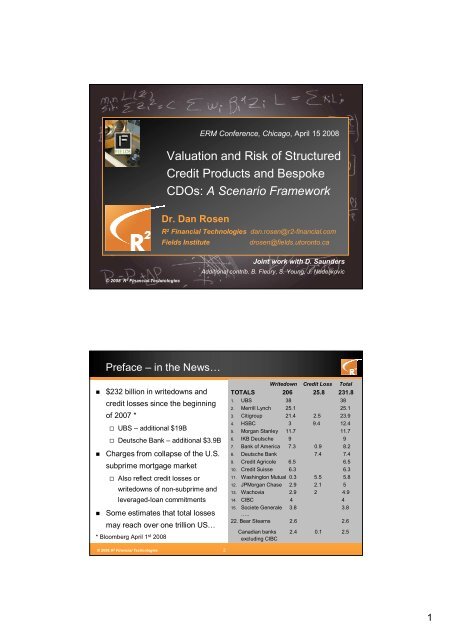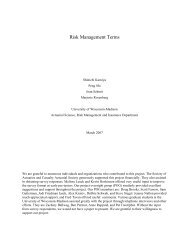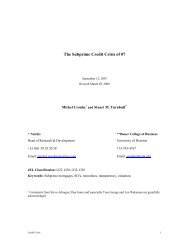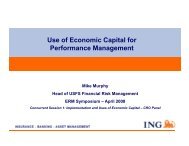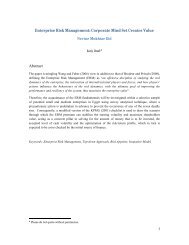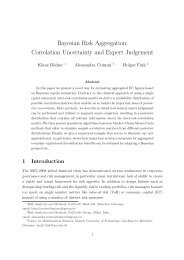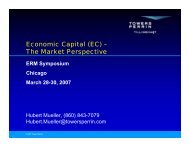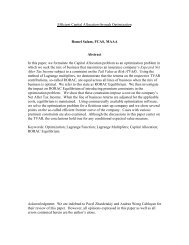A Scenario Framework - ERM Symposium
A Scenario Framework - ERM Symposium
A Scenario Framework - ERM Symposium
You also want an ePaper? Increase the reach of your titles
YUMPU automatically turns print PDFs into web optimized ePapers that Google loves.
© 2008 R 2 Financial Technologies<br />
Valuation and Risk of Structured<br />
Credit Products and Bespoke<br />
CDOs: A <strong>Scenario</strong> <strong>Framework</strong><br />
Dr. Dan Rosen<br />
R 2 Financial Technologies dan.rosen@r2-financial.com<br />
Fields Institute drosen@fields.utoronto.ca<br />
Preface – in the News…<br />
$232 billion in writedowns and<br />
credit losses since the beginning<br />
of 2007 *<br />
UBS – additional $19B<br />
Deutsche Bank – additional $3.9B<br />
Charges from collapse of the U.S.<br />
subprime mortgage market<br />
Also reflect credit losses or<br />
writedowns of non-subprime and<br />
leveraged-loan commitments<br />
Some estimates that total losses<br />
may reach over one trillion US…<br />
* Bloomberg April 1 st 2008<br />
© 2008 R 2 Financial Technologies 2<br />
<strong>ERM</strong> Conference, Chicago, April 15 2008<br />
Joint work with D. Saunders<br />
Additional contrib. B. Fleury, S. Young, J. Nedeljkovic<br />
Writedown Credit Loss Total<br />
TOTALS 206 25.8 231.8<br />
1. UBS 38 38<br />
2. Merrill Lynch 25.1 25.1<br />
3. Citigroup 21.4 2.5 23.9<br />
4. HSBC 3 9.4 12.4<br />
5. Morgan Stanley 11.7 11.7<br />
6. IKB Deutsche 9 9<br />
7. Bank of America 7.3 0.9 8.2<br />
8. Deutsche Bank 7.4 7.4<br />
9. Credit Agricole 6.5 6.5<br />
10. Credit Suisse 6.3 6.3<br />
11. Washington Mutual 0.3 5.5 5.8<br />
12. JPMorgan Chase 2.9 2.1 5<br />
13. Wachovia 2.9 2 4.9<br />
14. CIBC 4 4<br />
15. Societe Generale 3.8 3.8<br />
…..<br />
22. Bear Stearns 2.6 2.6<br />
Canadian banks 2.4 0.1 2.5<br />
excluding CIBC<br />
1
Preface – in the News…<br />
Investors blaming a “1 in 10,000 years” event…<br />
And then…<br />
“It all happened exactly like he said it would happen... In every single<br />
detail…”<br />
“The hedge fund creator's name was John Paulson… by making<br />
between $3 billion and $4 billion for himself in 2007, he<br />
appears to have set a Wall Street record… no one has ever<br />
made so much so fast.”<br />
© 2008 R 2 Financial Technologies 3<br />
Sources: Reuters, Risk, Banking Technology,, Dow Jones, FT,, G&M, Bloomberg<br />
Structured Credit – Valuation & Risk<br />
1. Lack of integrated view of synthetic and cash products and single-name<br />
credit derivatives: pricing and risk management<br />
2. Valuation of synthetic CDOs<br />
Gaussian copula framework still prevalent<br />
Pricing bespoke portfolios difficult – “mapping” models are generally ad-hoc<br />
Dynamic models and detailed bespooke models still in infancy<br />
3. Valuation of structured credit (cash CDOs, ABSs,…)<br />
Difficult, non-standard, computationally intensive<br />
IR, spreads, prepayment, credit (and correlation) risks<br />
Structures are complex and opaque<br />
Simple “bond models” and matrix pricing generally used – pricing based on<br />
ratings<br />
Advanced models are fairly new or not fully developed for all asset classes<br />
Standardized calibration is difficult to achieve<br />
© 2008 R 2 Financial Technologies 4<br />
2
Structured Credit – Valuation & Risk<br />
4. Risk modelling is immature (market and credit risk)<br />
Simple market risk sensitivities are generally used (e.g. CR01, etc.)<br />
Risk assessment and investment decision mainly driven by ratings<br />
VaR (market & credit) measures not easy to obtain and not used in general<br />
Risk contribution not well defined (non-linearities)<br />
Hedging has proven to be difficult and prone to large model errors<br />
Computationally intensive risk applications (e.g. name-specific sensitivities)<br />
Correlation is very important but difficult to assess<br />
High systematic risk<br />
© 2008 R 2 Financial Technologies 5<br />
Summary<br />
<strong>Scenario</strong> framework – Valuation and Risk Profiling<br />
Implied factor distributions and weighted MC techniques<br />
Multi-factor credit models – characterize correlations for different baskets<br />
Weighted Monte Carlo techniques (used in options pricing)<br />
CDO analytics and computational techniques<br />
Ability to incorporate a full bottom-up approach<br />
Basic idea: set of scenarios where instruments are consistently valued<br />
Imply “risk-neutral” distribution (process) for underlying systematic risk factors<br />
Observed (liquid) prices (e.g. CDSs, index tranches)<br />
Prior or “quality” preferences on distribution; subjective views<br />
Structured finance CDOs (ABS and CLO products)<br />
Flexibly incorporate cash-flow waterfalls, prepayment and LGD models<br />
Cash CDO = bespoke portfolio + complex cashflow waterfall<br />
Methodology is general (dynamic) – examples in paper use static models<br />
© 2008 R 2 Financial Technologies 6<br />
3
PART 1<br />
Introduction: Valuing CDOs<br />
© 2008 R 2 Financial Technologies 7<br />
Synthetic CDOs<br />
© 2008 R 2 Financial Technologies 8<br />
and Structured Credit<br />
Underlying pool of credit default swaps – divided into “tranches”<br />
Tranche<br />
Equity<br />
1st Mezzanine<br />
2nd Mezzanine<br />
Senior<br />
Super Senior<br />
L ,<br />
n j<br />
Attachment<br />
0%<br />
3%<br />
7%<br />
10%<br />
15%<br />
Detachment<br />
3%<br />
7%<br />
10%<br />
15%<br />
30%<br />
Size of the n-th tranche<br />
S = U N − A N = N ⋅ U − A )<br />
n<br />
n<br />
Cumulative portfolio loss of up to t j<br />
∑ N k ⋅ LGDk<br />
⋅<br />
k ≤t<br />
1<br />
L τ<br />
j =<br />
j<br />
k<br />
L = min( S , max( L − A<br />
n,<br />
j<br />
n<br />
j n<br />
n<br />
( n n<br />
Cumulative loss on the n-th tranche up to time tj<br />
A U<br />
n = An<br />
+ 1<br />
n<br />
L j<br />
, 0))<br />
4
Background – Pricing Synthetic CDOs<br />
Standard model for pricing synthetic CDOs: single-factor Gaussian<br />
copula (Li 2001)<br />
Codependence through a one-factor Gaussian copula of times to default<br />
Single parameter to estimate (correlation for all obligors in portfolio)<br />
Basic model does not simultaneously match market prices of all traded<br />
tranches<br />
“Correlation skew” – set of correlations that match the prices of all tranches<br />
Base correlations – alternative to tranche correlations<br />
Implied correlations of equity tranches with different attachment points<br />
(mezzanine/senior tranches as difference between two equity tranches)<br />
Interpolation (or extrapolation) model<br />
Calibrated to observed tranche prices (e.g iTraxx or CDX)<br />
Pricing of bespoke portfolios – mapping (risk of bespoke vs. index portfolio)<br />
© 2008 R 2 Financial Technologies 9<br />
Single-Factor Gaussian Copula (Times to Default)<br />
Cumulative default time<br />
distribution functions<br />
Creditworthiness index<br />
Z systematic factor (Gaussian)<br />
Default times<br />
Mapping to Gaussian<br />
Conditional on Z, default times<br />
are independent<br />
∑<br />
Explicit formulae for conditional<br />
default probabilities<br />
© 2008 R 2 Financial Technologies 10<br />
( τ ) ⋅ LGD ( )<br />
L 1 ⋅V<br />
τ<br />
k<br />
T = τ ≤T<br />
k<br />
k<br />
k<br />
k<br />
k<br />
k<br />
−1<br />
k<br />
τ = F Φ<br />
( ( Y ) )<br />
Z<br />
( t)<br />
= Pr(<br />
τ ≤ t Z ) q ( t)<br />
= Pr(<br />
τ > t Z )<br />
Z<br />
pk k<br />
j<br />
k<br />
p<br />
Z<br />
k<br />
( t)<br />
Y = ρ Z + 1−<br />
ρ ε<br />
k<br />
Fk k<br />
⎛ Φ<br />
= Φ⎜<br />
⎜<br />
⎝<br />
( t)<br />
= Pr( τ ≤ t)<br />
k<br />
( F ( t)<br />
) ⇔ τ ≤ t<br />
Yk ≤ Φ k<br />
k<br />
−1<br />
−1<br />
( F ( t)<br />
)<br />
k<br />
k<br />
k<br />
− ρ ⎞ k Z<br />
⎟<br />
1−<br />
ρ ⎟<br />
k ⎠<br />
k<br />
5
General <strong>Framework</strong>: Gaussian Copula Model<br />
1. <strong>Scenario</strong>s:<br />
systematic<br />
factors<br />
Z<br />
p<br />
2. Conditional<br />
def. prob.<br />
Z<br />
k<br />
( t)<br />
=<br />
⎛<br />
⎜<br />
Φ<br />
Φ<br />
⎜<br />
⎝<br />
( F ( t)<br />
)<br />
− ρ ⎞<br />
k Z<br />
⎟<br />
1−<br />
ρ ⎟<br />
k ⎠<br />
© 2008 R 2 Financial Technologies 11<br />
© 2008 R 2 Financial Technologies 12<br />
−1<br />
k<br />
3. Conditional<br />
portfolio losses<br />
(discounted)<br />
Conditionally independent obligor losses <br />
convolution methods:<br />
Recursions (Andersen et al, Hull-White)<br />
Full simulation (independent Bernoulli<br />
variables)<br />
LLN, or CLT approximation<br />
Poisson approximation<br />
L<br />
( Z ) = ∑ Nk<br />
⋅ LGDk<br />
( Z ) ⋅ τ t ( Z )<br />
k ≤ 1<br />
j j<br />
k<br />
General <strong>Framework</strong>: Gaussian Copula Model<br />
1. <strong>Scenario</strong>s:<br />
systematic<br />
factors<br />
Z<br />
p<br />
2. Conditional<br />
def. prob.<br />
Z<br />
k<br />
( t)<br />
=<br />
⎛<br />
⎜<br />
Φ<br />
Φ<br />
⎜<br />
⎝<br />
−1<br />
( F ( t)<br />
)<br />
k<br />
− ρ ⎞<br />
k Z<br />
⎟<br />
1−<br />
ρ ⎟<br />
k ⎠<br />
L ,<br />
n j<br />
3. Conditional<br />
portfolio losses<br />
(discounted)<br />
Conditional<br />
tranche losses<br />
L = min( S , max( L − A<br />
n,<br />
j<br />
n<br />
j n<br />
A U<br />
n = An<br />
+ 1<br />
n<br />
, 0))<br />
L j<br />
6
General <strong>Framework</strong>: Implied Factor Distributions<br />
1. <strong>Scenario</strong>s:<br />
systematic<br />
factors<br />
Z<br />
2. Conditional<br />
def. prob.<br />
p<br />
Z<br />
k<br />
( t)<br />
=<br />
⎛ Φ<br />
Φ⎜<br />
⎜<br />
⎝<br />
( F ( t)<br />
)<br />
− ρ ⎞ j Z<br />
⎟<br />
1−<br />
ρ ⎟<br />
j ⎠<br />
© 2008 R 2 Financial Technologies 13<br />
−1<br />
Calibration:<br />
k<br />
Correlation of<br />
each tranche j<br />
Base correlation<br />
Equity tranches<br />
© 2008 R 2 Financial Technologies 14<br />
3. Conditional<br />
portfolio losses<br />
(discounted)<br />
Bespoke Portfolios and Mappings<br />
0.8<br />
0.6<br />
0.4<br />
0.2<br />
0<br />
Conditional<br />
tranche losses<br />
Base Correlation (Poisson)<br />
4. Expected tranche<br />
losses & values<br />
+<br />
+<br />
0 - 3% 0 - 7% 0 - 10% 0 - 15% 0 - 30%<br />
CDXIG5YR CDXIG7YR CDXIG10YR<br />
Conditional<br />
value of<br />
tranches<br />
. . .<br />
______<br />
∑<br />
ω ∑ p<br />
ω ∑ pω<br />
ω<br />
pω<br />
E[<br />
V | Zω<br />
]<br />
ω E[<br />
V | Zω<br />
]<br />
E[<br />
V | Z ]<br />
Main idea: base correlations correspond to different levels of risk in the<br />
reference portfolio<br />
By finding the same risk levels on the bespoke portfolio – transfer the base<br />
correlation structure from the standard portfolio to the bespoke<br />
Generally, solve an equation of the form:<br />
S is a "risk statistic"; P the portfolio, u the detachment point), and rho is<br />
the base correlation (the unknown is ).<br />
Mapping: solve for the detachment point(s) in the bespoke portfolio<br />
which matches the equation:<br />
S ( Pˆ<br />
, uˆ<br />
, ρ) = S(<br />
P,<br />
u,<br />
ρ)<br />
Note: the base correlation for the standard portfolio is used on both sides<br />
û<br />
ω<br />
7
EL Mapping (Base Correlations)<br />
ρ(U)<br />
3% 7% 10% 15% 30% U<br />
© 2008 R 2 Financial Technologies 15<br />
Index Base Correlation Curve<br />
Bespoke Base Correlation Curve<br />
Understanding Bespoke Portfolios and Prices<br />
Differences in prices from bespoke portfolio and quoted (index)<br />
prices may arise from differences in<br />
Credit quality (individual names spreads/PDs)<br />
Concentration risk (sector/geographical, and name concentration)<br />
Sector concentration (indices are well diversified)<br />
Correlation (codependence)<br />
Granularity<br />
Reference to multiple indices (and different risk premia)<br />
Liquidity<br />
e.g. for an equity tranche:<br />
Higher quality (lower individual spreads) lower tranche spread<br />
Higher correlation lower spread<br />
Higher granularity (more names) higher spread<br />
Multiple indices lower average correlation higher spread<br />
© 2008 R 2 Financial Technologies 16<br />
8
Cash CDOs: “Bond” Models (Single-<strong>Scenario</strong>)<br />
Defaults<br />
Recoveries<br />
Prepayments<br />
Collateral<br />
Model<br />
Collateral<br />
Cash Flows<br />
Step 1: Gather collateral cash flow assumption<br />
vectors<br />
e.g. assumptions by type of CDO collateral (e.g. CRE,<br />
ABS, loan, bond)<br />
For ABS CDOs, can use loan performance analysis on<br />
the loans in each ABS<br />
Step 2: Generate cash flows for each piece of<br />
collateral<br />
CDO Model<br />
© 2008 R 2 Financial Technologies 17<br />
Senior Cash Flow<br />
Mezz Cash Flow<br />
Junior Cash Flow<br />
Equity Cash Flow<br />
Step 3: Use collateral CFs and CDO waterfall to<br />
generate CDO cash flows<br />
Step 4: NPV – discount cash flows (appropriate<br />
discount rate)<br />
Complex cashflow from collateral and structure waterfall<br />
Discount<br />
Discount<br />
Discount<br />
Discount<br />
Price<br />
Price<br />
Price<br />
Price<br />
Discount rate (spread) – from market quotes where available<br />
Application of discount rate to all other tranches with the<br />
same rating, deal type, vintage, etc.<br />
In addition to default, LGDs: prepayment (applies differently to tranches)<br />
Underlying: loans, bonds, retail loans (mortgages, credit cards, etc.), ABSs, CDOs<br />
(CDO^2)<br />
Cash CDOs: “Bond” Models (Single-<strong>Scenario</strong>)<br />
Single-scenario modelling<br />
Deterministic cash-flow approach (scheduled amortization)<br />
No direct modelling of correlations, optionality, non-linearities<br />
Detailed cash-flow modelling of collateral pool and of CDO waterfall<br />
Pool level assumptions and loan-level assumptions and clustering<br />
Comparative pricing via matrix approach (generally relies on ratings)<br />
<strong>Scenario</strong> assumptions, discount spreads (premiums)<br />
Useful stress-testing framework<br />
PV<br />
( Y )<br />
© 2008 R 2 Financial Technologies 18<br />
T<br />
∑<br />
=<br />
j=<br />
1<br />
CF<br />
j<br />
⋅ e<br />
−(<br />
r + s ( X ) ) ⋅t<br />
( PP,<br />
Def , LGD,...<br />
) = ( rating, sector, vintage, ... )<br />
Y<br />
= X<br />
j<br />
j<br />
9
PART 2<br />
<strong>Scenario</strong> <strong>Framework</strong>:<br />
Implied Factor Distributions<br />
and Weighted Monte Carlo Methods<br />
© 2008 R 2 Financial Technologies 19<br />
Credit Risk and Multi-Factor Models<br />
Multi-factor models are currently used extensively to asses portfolio<br />
credit risk and measure credit economic capital<br />
Capital allocation – capture sector/geographical concentrations<br />
Over a decade of industry experience: KMV, CreditMetrics,<br />
CreditRisk+, CreidtPortfolioView<br />
Conditional independence framework – mathematical equivalence<br />
Extensive empirical studies on estimation of credit correlation<br />
parameters (Basel committee, rating agencies, vendors, financial<br />
institutions and academics)<br />
The origins of the Gaussian copula method to price CDOs trace back<br />
to the KMV and CreditMetrics model<br />
© 2008 R 2 Financial Technologies 20<br />
10
Implied Factor Models & Weighted MC<br />
Background<br />
Weighted MC approach used to price complex options<br />
e.g. Avellaneda et al., 2001, Elices and Giménez, 2006<br />
Similar idea to fitting the implied distribution (or process) of<br />
underlying in a (discrete) lattice<br />
Hul-White’s “implied copula” model (2006) is essentially an<br />
application of this concept<br />
Homogeneous portfolio – cannot be used directly to price bespokes<br />
Similar ideas (also for homogeneous portfolios) in Brigo et al (2006),<br />
Torresetti et al (2006)<br />
© 2008 R 2 Financial Technologies 21<br />
Implied Factor Models & Weighted MC<br />
Assumptions<br />
Correlations of names in portfolio: multi-factor model (systematic factors)<br />
MF model joint default behaviour under real world measure P<br />
Coefficients of factor model for portfolio are known and fixed<br />
Difference between real measure P and RN-measure Q : joint<br />
distribution of the systematic factors<br />
(Marginal) distribution of default times for each name under the risk-neutral<br />
measure based on CDS spreads<br />
Conditional distribution of default times, as a function of the factor levels<br />
under the RN measure still given by the same formula<br />
Solution<br />
Sample discrete “paths” (in this case, single values) for the systematic<br />
factors and adjust probabilities of paths to match prices<br />
© 2008 R 2 Financial Technologies 22<br />
11
Weighted MC – GLLM <strong>Framework</strong><br />
Portfolio model can be a Gaussian copula or, more generally, we<br />
can use other “link functions”<br />
Logit, NIG, double-t, etc…<br />
Generalized linear mixed models (GLMM)<br />
Example of general multi-factor copula<br />
Match, for each name, the “unconditional” default probability term<br />
structure<br />
p<br />
( t)<br />
= h a(<br />
t)<br />
Z ( t)<br />
= p ( t)<br />
df ( z)<br />
… and match quoted CDO prices<br />
© 2008 R 2 Financial Technologies 23<br />
Z<br />
j<br />
p<br />
j ∫<br />
( −∑<br />
bk<br />
Zk<br />
)<br />
Weighted MC – GLLM <strong>Framework</strong><br />
General formulation:<br />
Gaussian copula:<br />
a<br />
Logit model:<br />
it<br />
=<br />
t<br />
PD ( Z ) = h<br />
−1<br />
1−<br />
© 2008 R 2 Financial Technologies 24<br />
Φ<br />
it<br />
( PD )<br />
it<br />
,<br />
j<br />
k<br />
p<br />
Z<br />
j<br />
K t t<br />
( ait<br />
+ bik<br />
Zk<br />
)<br />
b<br />
∑ k =<br />
K 2<br />
K<br />
∑ β<br />
−<br />
k = k 1<br />
1 ∑k<br />
=<br />
Poisson mixture (e.g. CreditRisk+)<br />
ik<br />
=<br />
K<br />
∑ k = 1<br />
1<br />
h(<br />
x)<br />
=<br />
( 1+<br />
exp( −x))<br />
β<br />
λ<br />
( Z)<br />
= E[<br />
U | Z]<br />
= c β Z<br />
i<br />
i<br />
i<br />
ik<br />
1<br />
k<br />
k<br />
β<br />
2<br />
1 k<br />
( t)<br />
⎛<br />
⎜ H<br />
= G j ⎜<br />
⎝<br />
−1<br />
( Fj<br />
( t)<br />
) −∑<br />
−∑<br />
β ⎞<br />
k k Zk<br />
⎟<br />
1<br />
2<br />
β k k<br />
⎟<br />
⎠<br />
12
General <strong>Framework</strong>: Weighted MC<br />
1. <strong>Scenario</strong>s:<br />
systematic<br />
factors<br />
q1<br />
q2<br />
q3<br />
Objective function (e.g. max.<br />
smoothness, max entropy, etc.)<br />
∑<br />
ω ∑ ω p<br />
ω<br />
pωE[<br />
V | Zω<br />
] = 0<br />
pω<br />
E[<br />
V | Zω<br />
] = 0<br />
E[<br />
V | Z ] = 0<br />
ω<br />
Z<br />
ω<br />
p<br />
2. Conditional<br />
def. prob.<br />
Z<br />
j<br />
( t)<br />
=<br />
⎛ Φ<br />
Φ⎜<br />
⎜<br />
⎝<br />
5. Optimization<br />
?<br />
( F ( t ) )<br />
− ρ ⎞ k Z<br />
⎟<br />
1−<br />
ρ ⎟<br />
k ⎠<br />
© 2008 R 2 Financial Technologies 25<br />
−1<br />
j<br />
3. Conditional<br />
portfolio losses<br />
(discounted)<br />
Global Factor Implied Distribution<br />
Conditional<br />
tranche losses<br />
4. Expected tranche<br />
losses & values<br />
Evolution of distribution – from prior to tight fit of prices<br />
© 2008 R 2 Financial Technologies 26<br />
+<br />
+<br />
Conditional<br />
value of<br />
tranches<br />
. . .<br />
______<br />
∑<br />
ω ∑ p<br />
ω ∑ pω<br />
ω<br />
pω<br />
E[<br />
V | Zω<br />
]<br />
ω E[<br />
V | Zω<br />
]<br />
E[<br />
V | Z ]<br />
ω<br />
13
Implied Factor Distributions – Intuition<br />
Key objective: tractable distribution of joint default times – match<br />
marginal distributions and prices of CDSs and quoted CDO tranches<br />
In a Gaussian copula – conditioning on the systemic factor<br />
( t)<br />
⎛ Φ<br />
= Φ⎜<br />
⎜<br />
⎝<br />
−1<br />
( F ( t)<br />
)<br />
© 2008 R 2 Financial Technologies 27<br />
p<br />
Z<br />
j<br />
j<br />
− ρ Z ⎞<br />
⎟<br />
1−<br />
ρ ⎟<br />
⎠<br />
Base correlations the correlation rho is a function of the<br />
detachment point<br />
Implied copula model directly conditional PDs through discrete<br />
scenarios (on a hazard rate) for homogeneous portfolio<br />
Implied multi-factor distribution model directly the distribution of<br />
the systematic risk factor through discrete scenarios conditional<br />
default probabilities through the copula “mapping”<br />
Extensible to multi-factor and applied to other portfolios<br />
Weighted MC – Optimization problem<br />
Objective function factor distribution “quality”:<br />
min. distance from prior, max. entropy, max. smoothness<br />
Match tranche and index prices (can be more than one index at a time)<br />
Match CDS prices (cumulative default probabilities for all names)<br />
max G(<br />
q)<br />
M<br />
m<br />
n m<br />
( Z ) = ∑q<br />
mPV<br />
Sell ( Z )<br />
Trade-off: well-behaved “smooth” solution might be preferred over<br />
perfect matching of prices (with some bounds)<br />
Instead of perfect “perfect match” – minimize price differences<br />
© 2008 R 2 Financial Technologies 28<br />
M<br />
∑<br />
M<br />
M<br />
q<br />
m<br />
m=<br />
1<br />
∑<br />
q<br />
m<br />
m=<br />
1<br />
∑<br />
q<br />
m<br />
m=<br />
1<br />
PV<br />
PD<br />
n<br />
Buy<br />
i,<br />
j<br />
= 1 ,<br />
subject to :<br />
m<br />
( Z ) = F<br />
q<br />
m<br />
m=<br />
1<br />
i,<br />
j<br />
≥ 0<br />
for all i,<br />
j<br />
for all<br />
m<br />
for all<br />
n<br />
14
Weighted MC – Computation<br />
Computational issues<br />
Each path requires computing the conditional portfolio loss<br />
distribution – trade-off between number of paths and accuracy of<br />
these distributions<br />
Number of paths<br />
Low dimensions – numerical integration<br />
More generally – Quasi-MC methods (low discrepancy<br />
sequences)<br />
Trade-off: nice behaved “smooth” solution might be preferred over<br />
perfect matching of prices (with some bounds of course)<br />
© 2008 R 2 Financial Technologies 29<br />
Weighted MC – <strong>Scenario</strong> Generation<br />
Quasi Monte Carlo methods<br />
Deterministic points generated from<br />
a type of mathematical vector<br />
sequences: low discrepancy<br />
sequences (LDS)<br />
Basic idea:<br />
LDSs specifically attempt to cover<br />
the space of risk factors “evenly” -<br />
avoiding the clustering usually<br />
associated with pseudo-random<br />
sampling<br />
Number of scenarios necessary to<br />
achieve a desired level of accuracy<br />
in pricing or risk calculations is<br />
reduced<br />
© 2008 R 2 Financial Technologies 30<br />
Source: Dembo et al. (1999), Mark-to-Future<br />
15
PART 3<br />
© 2008 R 2 Financial Technologies 31<br />
Examples<br />
1. ABX and cash CDO<br />
2. CLO and HY Index<br />
Examples<br />
3. Bespoke synthetic CDO in Multi-factor model (sector<br />
concentrations)<br />
4. Bespoke synthetic CDO with names in Europe and NA<br />
(two indices)<br />
© 2008 R 2 Financial Technologies 32<br />
16
Example 1 – ABX<br />
ABX –referencing 20 Asset Backed CDS (ABCDS)<br />
Home Equity / Sub-prime Bonds (thousands of small loans)<br />
Five indices: AAA / AA / A / BBB / BBB-<br />
Trading Began January 2006<br />
Standard prices and quotes<br />
Modelling issues<br />
Default risk and prepayment risk<br />
Cash-flow generation<br />
(underlying loans, bond (and CDS) waterfall<br />
Defaults<br />
LGD/recoveries<br />
Prepayments<br />
Other factors<br />
Collateral<br />
cash-flow<br />
engine<br />
© 2008 R 2 Financial Technologies 33<br />
© 2008 R 2 Financial Technologies 34<br />
Collateral<br />
Cash Flows<br />
Example – ABX Valuation Model<br />
Simple valuation model (illustration purposes)<br />
Single systematic factor – drives<br />
Default rates<br />
Prepayment rates<br />
Recovery rates<br />
(underlying loans in the pools)<br />
Large homogeneous<br />
portfolio assumption<br />
Discretization<br />
90.00%<br />
80.00%<br />
70.00%<br />
60.00%<br />
50.00%<br />
40.00%<br />
30.00%<br />
20.00%<br />
135 systematic factor<br />
10.00%<br />
scenarios 0.00%<br />
ABX MktPrice<br />
ABX-XHAAA72_INDEX 91.81<br />
ABX-XHAA72_INDEX 71.06<br />
ABX-XHA72_INDEX 44.31<br />
ABX-XHBBB72_INDEX 26<br />
ABX-XHBBBM72_INDEX 23<br />
CDO<br />
waterfall<br />
p<br />
Z<br />
j<br />
( t)<br />
= h a(<br />
t)<br />
Senior tranche<br />
Mezz tranche<br />
Junior tranche<br />
Equity tranche<br />
( −∑<br />
b ) k k Z k<br />
1<br />
6<br />
11<br />
16<br />
21<br />
26<br />
31<br />
36<br />
41<br />
46<br />
51<br />
56<br />
61<br />
66<br />
71<br />
76<br />
81<br />
86<br />
91<br />
96<br />
101<br />
106<br />
111<br />
116<br />
121<br />
126<br />
131<br />
PD LGD PP<br />
17
Example – ABX Valuation under <strong>Scenario</strong>s<br />
ABX bonds discounted Cashflows (values) under scenarios<br />
ABX MktPrice<br />
ABX-XHAAA72_INDEX 91.81<br />
ABX-XHAA72_INDEX 71.06<br />
ABX-XHA72_INDEX 44.31<br />
ABX-XHBBB72_INDEX 26<br />
ABX-XHBBBM72_INDEX 23<br />
90.00%<br />
80.00%<br />
70.00%<br />
60.00%<br />
50.00%<br />
40.00%<br />
30.00%<br />
20.00%<br />
10.00%<br />
$160.00<br />
$140.00<br />
$120.00<br />
$100.00<br />
$80.00<br />
$60.00<br />
$40.00<br />
$20.00<br />
$0.00<br />
1<br />
6<br />
© 2008 R 2 Financial Technologies 35<br />
© 2008 R 2 Financial Technologies 36<br />
0.00%<br />
11<br />
16<br />
21<br />
26<br />
31<br />
36<br />
41<br />
46<br />
1<br />
5<br />
9<br />
13<br />
17<br />
21<br />
25<br />
29<br />
33<br />
37<br />
41<br />
45<br />
49<br />
53<br />
57<br />
61<br />
65<br />
69<br />
73<br />
77<br />
81<br />
85<br />
89<br />
93<br />
97<br />
51<br />
56<br />
PD LGD PP<br />
71<br />
76<br />
81<br />
86<br />
91<br />
96<br />
101<br />
106<br />
111<br />
116<br />
121<br />
126<br />
131<br />
61<br />
66<br />
ABX-XHAAA72_INDEX ABX-XHAA72_INDEX ABX-XHA72_INDEX<br />
ABX-XHBBB72_INDEX ABX-XHBBBM72_INDEX<br />
Example – ABX Valuation and Calibration<br />
Example:<br />
Weighted MC implied factor distribution (implied scenario weights)<br />
Vasicek PD distribution<br />
(Gaussian copula GLLM)<br />
Implied avg. PD = 12%<br />
90.00%<br />
80.00%<br />
70.00%<br />
60.00%<br />
50.00%<br />
40.00%<br />
30.00%<br />
20.00%<br />
10.00%<br />
$20.00<br />
Implied correlation = 7% $0.00<br />
Market Price Estimated Prices<br />
ABX-XHAAA72 91.81 103.06<br />
ABX-XHAA72 71.06 94.40<br />
ABX-XHA72 44.31 78.89<br />
ABX-XHBBB72 26 57.19<br />
ABX-XHBBBM72 23 48.47<br />
0.00%<br />
$160.00<br />
$140.00<br />
$120.00<br />
$100.00<br />
$80.00<br />
$60.00<br />
$40.00<br />
2.5 0%<br />
2.0 0%<br />
1.5 0%<br />
1.0 0%<br />
0.5 0%<br />
0.0 0%<br />
1<br />
5<br />
1<br />
9<br />
6<br />
11<br />
13<br />
17<br />
16<br />
21<br />
26<br />
31<br />
36<br />
41<br />
1<br />
5<br />
9<br />
13<br />
17<br />
21<br />
25<br />
29<br />
33<br />
37<br />
41<br />
45<br />
49<br />
53<br />
57<br />
61<br />
65<br />
69<br />
73<br />
77<br />
81<br />
85<br />
89<br />
93<br />
97<br />
46<br />
51<br />
56<br />
PD LGD PP<br />
61<br />
66<br />
ABX-XHAAA72_INDEX ABX-XHAA72_INDEX ABX-XHA72_INDEX<br />
ABX-XHBBB72_INDEX ABX-XHBBBM72_INDEX<br />
21<br />
25<br />
29<br />
33<br />
37<br />
41<br />
45<br />
49<br />
53<br />
57<br />
61<br />
65<br />
69<br />
73<br />
77<br />
81<br />
71<br />
76<br />
81<br />
86<br />
91<br />
96<br />
101<br />
106<br />
101<br />
105<br />
109<br />
113<br />
117<br />
121<br />
125<br />
129<br />
133<br />
111<br />
101<br />
105<br />
109<br />
113<br />
117<br />
121<br />
125<br />
129<br />
133<br />
85<br />
89<br />
93<br />
97<br />
101<br />
105<br />
109<br />
113<br />
117<br />
121<br />
125<br />
129<br />
116<br />
121<br />
126<br />
131<br />
18
0.4<br />
0.35<br />
0.3<br />
0.25<br />
0.2<br />
0.15<br />
0.1<br />
0.05<br />
0<br />
0.045<br />
0.04<br />
0.035<br />
0.03<br />
0.025<br />
0.02<br />
0.015<br />
0.01<br />
0.005<br />
0<br />
1.60%<br />
1.40%<br />
1.20%<br />
1.00%<br />
0.80%<br />
0.60%<br />
0.40%<br />
0.20%<br />
0.00%<br />
Example – ABX Valuation and Calibration<br />
1<br />
5<br />
9<br />
13<br />
17<br />
21<br />
25<br />
29<br />
33<br />
37<br />
41<br />
45<br />
49<br />
53<br />
57<br />
61<br />
65<br />
69<br />
73<br />
77<br />
81<br />
85<br />
89<br />
93<br />
97<br />
101<br />
105<br />
109<br />
113<br />
117<br />
121<br />
125<br />
129<br />
133<br />
1<br />
5<br />
9<br />
13<br />
17<br />
21<br />
25<br />
29<br />
33<br />
37<br />
41<br />
45<br />
49<br />
53<br />
57<br />
61<br />
65<br />
69<br />
73<br />
77<br />
81<br />
85<br />
89<br />
93<br />
97<br />
101<br />
105<br />
109<br />
113<br />
117<br />
121<br />
125<br />
129<br />
133<br />
1<br />
5<br />
9<br />
13<br />
17<br />
21<br />
25<br />
29<br />
33<br />
37<br />
41<br />
45<br />
49<br />
53<br />
57<br />
61<br />
65<br />
69<br />
73<br />
77<br />
81<br />
85<br />
89<br />
93<br />
97<br />
101<br />
105<br />
109<br />
113<br />
117<br />
121<br />
125<br />
129<br />
© 2008 R 2 Financial Technologies 37<br />
Example – Valuing ABS CDO<br />
Four Steps<br />
© 2008 R 2 Financial Technologies 38<br />
Market Price Model Prices<br />
ABX-XHAAA72_INDEX 91.81 97.66 5.99%<br />
ABX-XHAA72_INDEX 71.06 69.91 -1.65%<br />
ABX-XHA72_INDEX 44.31 44.69 0.86%<br />
ABX-XHBBB72_INDEX 26 25.84 -0.63%<br />
ABX-XHBBBM72_INDEX 23 23.02 0.08%<br />
Market Price Model Price<br />
ABX-XHAAA72_INDEX 91.81 98.46 7.2%<br />
ABX-XHAA72_INDEX 71.06 69.59 -2.1%<br />
ABX-XHA72_INDEX 44.31 44.94 1.4%<br />
ABX-XHBBB72_INDEX 26 26.04 0.2%<br />
ABX-XHBBBM72_INDEX 23 22.70 -1.3%<br />
7.8%<br />
Market Price Model Price<br />
ABX-XHAAA72 91.81 101.46 10.5%<br />
ABX-XHAA72 71.06 69.07 -2.8%<br />
ABX-XHA72 44.31 45.35 2.3%<br />
ABX-XHBBB72 26 27.21 4.7%<br />
ABX-XHBBBM72 23 21.70 -5.7%<br />
13.3%<br />
1. Factor scenarios PD, PP, LGD scenarios for new CDO (factor models)<br />
2. CDO PV scenarios from cash-flow and waterfall engines<br />
3. Valuation using pre-calibrated model<br />
90 .00 %<br />
80 .00 %<br />
70 .00 %<br />
60 .00 %<br />
50 .00 %<br />
40 .00 %<br />
30 .00 %<br />
20 .00 %<br />
10 .00 %<br />
0 .00 %<br />
ABX PD, PP, LGD<br />
1<br />
6<br />
1 1 6<br />
2 1<br />
2 6<br />
3 1<br />
3 6<br />
4 1<br />
4 6<br />
5 1<br />
5 6<br />
6 1<br />
6 7 1<br />
7 6<br />
8 1<br />
8 6<br />
9 1<br />
9 6<br />
1 0 1<br />
1 0 6<br />
1 1 6<br />
1 2 1<br />
1 2 6<br />
1 3 1<br />
PD L GD PP<br />
90.00%<br />
80.00%<br />
70.00%<br />
60.00%<br />
50.00%<br />
40.00%<br />
30.00%<br />
20.00%<br />
10.00%<br />
0.00%<br />
CDO PD, PP, LGD<br />
1<br />
6<br />
1 1<br />
1 6<br />
2 1<br />
2 6<br />
3 1<br />
3 6<br />
4 1<br />
4 6<br />
5 1<br />
5 6<br />
6 1<br />
6 6<br />
7 1<br />
7 6<br />
8 1<br />
8 6<br />
9 1<br />
9 6<br />
10 1<br />
10 6<br />
11 1<br />
11 6<br />
12 1<br />
12 6<br />
13 1<br />
PD LGD PP<br />
4. Sensitivities and risk measures<br />
5. Model risk assessment<br />
$ 160.00<br />
$ 140.00<br />
$ 120.00<br />
$ 100.00<br />
“Plausible” factor distributions<br />
PD, PP, LGD model assumptions<br />
Stress testing and extreme scenarios<br />
$80.00<br />
$60.00<br />
$40.00<br />
$20.00<br />
$0.00<br />
1<br />
6<br />
11<br />
16<br />
21<br />
26<br />
31<br />
36<br />
41<br />
46<br />
51<br />
56<br />
61<br />
66<br />
71<br />
76<br />
81<br />
86<br />
91<br />
96<br />
1 01<br />
1 06<br />
1 11<br />
1 16<br />
1 21<br />
1 26<br />
1 31<br />
ABX-XHAAA72_IND EX ABX-XHAA72_INDEX ABX-XHA72 _INDEX<br />
ABX-XHBBB72_IND EX ABX-XHBBBM72_ INDEX<br />
0.035<br />
0.03<br />
0.025<br />
0.02<br />
0.015<br />
0.01<br />
0.005<br />
0<br />
1<br />
5<br />
9<br />
13<br />
17<br />
21<br />
25<br />
29<br />
33<br />
37<br />
41<br />
45<br />
49<br />
53<br />
57<br />
61<br />
65<br />
69<br />
73<br />
77<br />
81<br />
85<br />
89<br />
93<br />
97<br />
1 01<br />
1 05<br />
1 09<br />
1 13<br />
1 17<br />
1 21<br />
1 25<br />
1 29<br />
1 33<br />
90.00 %<br />
80.00 %<br />
70.00 %<br />
60.00 %<br />
50.00 %<br />
40.00 %<br />
30.00 %<br />
20.00 %<br />
10.00 %<br />
0.00%<br />
0.4<br />
0.35<br />
0.3<br />
0.25<br />
0.2<br />
0.15<br />
0.1<br />
0.05<br />
0<br />
X<br />
1<br />
6<br />
11<br />
16<br />
21<br />
26<br />
31<br />
36<br />
41<br />
46<br />
51<br />
56<br />
61<br />
66<br />
71<br />
76<br />
81<br />
86<br />
91<br />
96<br />
101<br />
106<br />
111<br />
116<br />
121<br />
126<br />
131<br />
PD L GD PP<br />
0.035<br />
0.03<br />
0.025<br />
0.02<br />
0.015<br />
0.01<br />
0.005<br />
0<br />
1<br />
5<br />
9<br />
1 3<br />
1 7<br />
2 1<br />
2 5<br />
2 9<br />
3 3 7<br />
4 1<br />
4 5<br />
4 9<br />
5 3<br />
5 7<br />
6 1<br />
6 5<br />
6 9<br />
7 3<br />
7 8 1<br />
8 5<br />
8 9<br />
9 3<br />
9 7<br />
10 1<br />
10 5<br />
10 9<br />
11 3<br />
11 7<br />
12 1<br />
12 5<br />
12 9<br />
13 3<br />
$1 60.00<br />
$1 40.00<br />
$1 20.00<br />
$1 00.00<br />
$8 0.00<br />
$6 0.00<br />
$4 0.00<br />
$2 0.00<br />
$ 0.00<br />
Best fitted<br />
prices<br />
Smoothed<br />
distribution<br />
(nonparametric)<br />
Optimal<br />
parametric<br />
Distribution<br />
PD=16.5<br />
R=7%<br />
1<br />
5<br />
9<br />
13<br />
17<br />
21<br />
25<br />
29<br />
33<br />
37<br />
41<br />
45<br />
49<br />
53<br />
57<br />
61<br />
65<br />
69<br />
73<br />
77<br />
81<br />
85<br />
89<br />
93<br />
97<br />
1 01<br />
1 05<br />
1 09<br />
1 13<br />
1 17<br />
1 21<br />
1 25<br />
1 29<br />
1 33<br />
1.80%<br />
1.60%<br />
1.40%<br />
1.20%<br />
1.00%<br />
0.80%<br />
0.60%<br />
0.40%<br />
0.20%<br />
0.00%<br />
1<br />
6<br />
11<br />
16<br />
21<br />
26<br />
31<br />
36<br />
41<br />
46<br />
51<br />
56<br />
61<br />
66<br />
71<br />
76<br />
81<br />
86<br />
91<br />
96<br />
1 01<br />
1 06<br />
1 11<br />
1 16<br />
1 21<br />
1 26<br />
1 31<br />
A BX -XHA AA 72_INDE X A BX -X HA A72 _INDEX A BX -X HA 72_INDE X<br />
A BX -XHB BB 72_INDE X A BX -X HB BB M72_INDE X<br />
1<br />
5<br />
9<br />
13<br />
17<br />
21<br />
25<br />
29<br />
33<br />
37<br />
41<br />
45<br />
49<br />
53<br />
57<br />
61<br />
65<br />
69<br />
73<br />
77<br />
81<br />
85<br />
89<br />
93<br />
97<br />
1 01<br />
1 05<br />
1 09<br />
1 13<br />
1 17<br />
1 21<br />
1 25<br />
1 29<br />
19
Example 2 – CLO Valuation<br />
Tranche Price<br />
A1 $ 101.02<br />
A2 $ 90.97<br />
B $ 77.16<br />
C $ 67.01<br />
D $ 70.77<br />
120.00%<br />
100.00%<br />
0.045<br />
80.00%<br />
60.00%<br />
40.00%<br />
20.00%<br />
0.04<br />
0.035<br />
0.03<br />
0.025<br />
0.02<br />
0.015<br />
0.01<br />
0.005<br />
0.00%<br />
0<br />
-5<br />
Conditional PD, LGD, and PP (on factor Z)<br />
-5.00<br />
-4.60<br />
-4.20<br />
-3.80<br />
-3.40<br />
-3.00<br />
-2.60<br />
-2.20<br />
-1.80<br />
-1.40<br />
-1.00<br />
-0.60<br />
-0.20<br />
0.20<br />
0.60<br />
1.00<br />
1.40<br />
1.80<br />
2.20<br />
2.60<br />
3.00<br />
3.40<br />
3.80<br />
4.20<br />
4.60<br />
5.00<br />
Loss Given Default Average Conditional<br />
PD (@5y)<br />
Factor Distribution<br />
Average Conditional<br />
PP (@5y)<br />
-4.6<br />
-4.2<br />
-3.8<br />
-3.4<br />
-3<br />
-2.6<br />
-2.2<br />
-1.8<br />
-1.4<br />
-1<br />
-0.6<br />
-0.2<br />
0.2<br />
0.6<br />
1<br />
1.4<br />
1.8<br />
2.2<br />
2.6<br />
3<br />
3.4<br />
3.8<br />
4.2<br />
4.6<br />
5<br />
© 2008 R 2 Financial Technologies 39<br />
Example – CLO Valuation<br />
Tranche Price Price<br />
A1 $ $ 101.02 76.60<br />
A2 $ $ 90.97 67.24<br />
B $ $ 77.16 43.32<br />
C $ $ 67.01 22.50<br />
D $ $<br />
70.77 23.81<br />
120.00%<br />
100.00%<br />
0.045<br />
80.00%<br />
60.00%<br />
40.00%<br />
20.00%<br />
0.04<br />
0.035<br />
0.03<br />
0.025<br />
0.02<br />
0.015<br />
0.01<br />
0.005<br />
0.00%<br />
0<br />
-5<br />
Conditional PD, LGD, and PP (on factor Z)<br />
-5.00<br />
-4.60<br />
-4.20<br />
-3.80<br />
-3.40<br />
-3.00<br />
-2.60<br />
-2.20<br />
-1.80<br />
-1.40<br />
-1.00<br />
-0.60<br />
-0.20<br />
0.20<br />
0.60<br />
1.00<br />
1.40<br />
1.80<br />
2.20<br />
2.60<br />
3.00<br />
3.40<br />
3.80<br />
4.20<br />
4.60<br />
5.00<br />
Loss Given Default Average Conditional<br />
PD (@5y)<br />
Factor Distribution<br />
Average Conditional<br />
PP (@5y)<br />
-4.6<br />
-4.2<br />
-3.8<br />
-3.4<br />
-3<br />
-2.6<br />
-2.2<br />
-1.8<br />
-1.4<br />
-1<br />
-0.6<br />
-0.2<br />
0.2<br />
0.6<br />
1<br />
1.4<br />
1.8<br />
2.2<br />
2.6<br />
3<br />
3.4<br />
3.8<br />
4.2<br />
4.6<br />
5<br />
© 2008 R 2 Financial Technologies 40<br />
Conditional Tranche Values<br />
40<br />
35<br />
30<br />
25<br />
20<br />
15<br />
10<br />
5<br />
0<br />
Conditional Tranche Values<br />
40<br />
35<br />
30<br />
25<br />
20<br />
15<br />
10<br />
5<br />
0<br />
140<br />
120<br />
100<br />
80<br />
60<br />
40<br />
20<br />
-5.00<br />
-4.50<br />
-4.00<br />
-3.50<br />
Tranche values across factor scenarios (mean)<br />
0<br />
-5 -4 -3 -2 -1 0 1 2 3 4 5<br />
140<br />
120<br />
100<br />
80<br />
60<br />
40<br />
20<br />
-5.00<br />
-4.50<br />
-4.00<br />
-3.50<br />
Tranche prices across systematic factor (sigma)<br />
-3.00<br />
-2.50<br />
-3.00<br />
-2.50<br />
-2.00<br />
-1.50<br />
-2.00<br />
-1.50<br />
-1.00<br />
-0.50<br />
-1.00<br />
-0.50<br />
Factor<br />
0.00<br />
0.50<br />
0.00<br />
0.50<br />
1.00<br />
1.50<br />
1.00<br />
1.50<br />
2.00<br />
2.50<br />
2.00<br />
2.50<br />
3.00<br />
3.50<br />
3.00<br />
3.50<br />
4.00<br />
4.50<br />
Tranche values across factor scenarios (mean)<br />
0<br />
-5 -4 -3 -2 -1 0 1 2 3 4 5<br />
Factor<br />
Tranche prices across systematic factor (sigma)<br />
4.00<br />
4.50<br />
5.00<br />
5.00<br />
A1<br />
A2<br />
B<br />
C<br />
D<br />
A1<br />
A2<br />
B<br />
C<br />
D<br />
A1<br />
A2<br />
B<br />
C<br />
D<br />
A1<br />
A2<br />
B<br />
C<br />
D<br />
20
Example 3: Multi-Factor Model & Bespoke Synthetic<br />
Industry concentration by Notional<br />
CDX HY CDX IG ITRAXX EUR ITRAXX CJ ITRAXX ASIA<br />
Exposure Per Name 10MM 8MM 8MM 20MM 1B<br />
Number of Names 100 125 125 50 50<br />
Industry (Fitch)<br />
Aerospace & Defence 3.00% 4.00% 2.40%<br />
Automobiles 9.00% 7.20% 4.00% 4.00%<br />
Banking & Finance 3.00% 17.60% 20.00% 20.00% 24.00%<br />
Broadcasting/Media/Cable 7.00% 8.00% 7.20%<br />
Business Services 4.00% 1.60% 10.00%<br />
Building & Materials 4.00% 3.20% 4.00% 6.00%<br />
Chemicals 6.00% 3.20% 4.80% 2.00% 2.00%<br />
Computers & Electronics 10.00% 4.00% 1.60% 8.00% 6.00%<br />
Consumer Products 5.00% 3.20% 3.20% 4.00%<br />
Energy 10.00% 4.80% 1.60% 10.00%<br />
Food, Beverage & Tobacco 4.00% 5.60% 7.20% 4.00%<br />
Gaming, Leisure & Entertainment 3.00% 1.60% 0.00% 2.00%<br />
Health Care & Pharmaceuticals 3.00% 5.60% 0.80% 0.00%<br />
Industrial/Manufacturing 2.00% 3.20% 2.40% 8.00% 6.00%<br />
Lodging & Restaurants 3.00% 3.20% 0.80%<br />
Metals & Mining 2.00% 1.60% 0.80% 12.00% 4.00%<br />
Packaging & Containers 2.00%<br />
Paper & Forest Products 5.00% 3.20% 1.60%<br />
Real Estate 1.60% 0.00% 4.00%<br />
Retail (general) 3.00% 6.40% 4.00% 4.00% 8.00%<br />
Supermarkets & Drugstores 1.00% 4.80% 4.80%<br />
Telecommunications 4.00% 4.80% 8.80% 2.00% 12.00%<br />
Transportation 3.00% 4.80% 0.80% 8.00% 4.00%<br />
Utilities 4.00% 5.60% 14.40% 4.00% 4.00%<br />
Sovereign 14.00%<br />
Herfindahl 5.7% 7.0% 9.5% 9.8% 12.2%<br />
Effective number of sectors 17.5 14.2 10.5 10.2 8.2<br />
© 2008 R 2 Financial Technologies 41<br />
Weighted MC and CDX Index Prices<br />
© 2008 R 2 Financial Technologies 42<br />
CDX IG<br />
Aer ospac e & Defence Automobiles Banking & Finance<br />
Broadcas ting/Media/Cable Business Serv ices Building & Materials<br />
Chemicals Computer s & Electronics Cons umer Products<br />
Energy Food, Bev erage & Tobac co Gaming, Leisure & Entertainment<br />
Health Care & Pharmaceuticals Industrial/Manufacturing Lodging & Restaurants<br />
Metals & Mining Packaging & Containers Paper & Forest Products<br />
Real Estate Retail (general) Supermarkets & Drugstor es<br />
Telecommunic ations Transportation Utilities<br />
Sov ereign<br />
ITRAXX EUR<br />
Aerospace & Def ence Automobiles Banking & Financ e<br />
Broadcasting/Media/Cable Business Services Building & Materials<br />
Chemicals Computers & Electronics Consumer Products<br />
Energy Food, Bev erage & Tobacco Gaming, Leisure & Entertainment<br />
Health Care & Pharmaceuticals Industrial/Manufacturing Lodging & Restaurants<br />
Metals & Mining Packaging & Containers Paper & Forest Products<br />
Real Estate Retail (general) Supermarkets & Drugstores<br />
Telecommunications Transportation Utilities<br />
Sov ereign<br />
Penalties<br />
MEAN<br />
Global factor statistics<br />
STD SKEW EX.KURT 0-3%<br />
Tranche Prices<br />
3-7% 7-10% 10-15% 15-30%<br />
None 0.00 0.99 -0.11 -0.27 28.47% 229.06 45.97 9.81 1.12<br />
level 1 0.37 1.90 1.49 1.02 32.31% 118.39 32.85 23.27 9.47<br />
level 2 0.30 1.81 1.68 2.05 32.22% 111.58 34.8 18.67 10.37<br />
level 3 0.22 1.69 1.90 3.33 32.04% 106.54 30.78 16.12 10.77<br />
level 4 0.14 1.54 2.23 5.01 31.89% 101.58 24.46 12.47 7.5<br />
Final 0.12 1.47 2.42 5.98 31.82% 99.35 21.47 10.77 5.77<br />
MARKET 31.81% 99 21 10.5 5.5<br />
21
Bespoke Portfolios and Concentration<br />
Sector<br />
(aggregate)<br />
TECH<br />
SERVICE<br />
PHARMA<br />
RETAIL<br />
FINANCE<br />
INDUSTRY<br />
ENERGY<br />
HI<br />
No. Eff.<br />
sectors<br />
CDX Index<br />
Weight<br />
(Notional)<br />
20.8%<br />
9.6%<br />
5.6%<br />
20.0%<br />
19.2%<br />
9.6%<br />
15.2%<br />
0.16<br />
6.07<br />
Weight<br />
(EL)<br />
21.4%<br />
10.9%<br />
3.6%<br />
29.0%<br />
11.8%<br />
9.9%<br />
13.5%<br />
0.19<br />
5.40<br />
Weight<br />
(Notional)<br />
20%<br />
15%<br />
17.5%<br />
10%<br />
15%<br />
17.5%<br />
0.16<br />
6.30<br />
© 2008 R 2 Financial Technologies 43<br />
Bespoke Portfolio<br />
(40)<br />
5%<br />
Weight<br />
(EL)<br />
14.5%<br />
16.7%<br />
3.9%<br />
27.2%<br />
6.6%<br />
14.2%<br />
16.9%<br />
0.18<br />
5.63<br />
Bespoke Portfolio<br />
(20)<br />
Weight<br />
(Notional)<br />
50%<br />
50%<br />
0.50<br />
2.00<br />
Weight<br />
(EL)<br />
72.3%<br />
27.7%<br />
0.60<br />
1.67<br />
Avg 5yr PD Index = 3.65% 40 Name = 3.92% 20 Name = 3.36%<br />
EL Mapping<br />
20 Names<br />
40 Names<br />
© 2008 R 2 Financial Technologies 44<br />
Tranche<br />
0 - 3%<br />
3 - 7%<br />
7-10%<br />
10-15%<br />
15-30%<br />
CDX<br />
Point<br />
3%<br />
7%<br />
10%<br />
15%<br />
30%<br />
EL Mapped<br />
Point (40)<br />
3.45%<br />
7.01%<br />
9.75%<br />
14.01%<br />
27.77%<br />
PRICES<br />
Index Bespoke<br />
(40)<br />
31.81%<br />
99<br />
21<br />
9.9<br />
5.5<br />
34.04%<br />
139<br />
43<br />
18<br />
0<br />
EL Mapped<br />
Point (20)<br />
3.17%<br />
5.89%<br />
7.98%<br />
11.55%<br />
24.65%<br />
Bespoke<br />
(20)<br />
28.26%<br />
113<br />
29<br />
11<br />
0<br />
22
Example – Bespoke (40 Names)<br />
Penalties<br />
0-3%<br />
Tranche Prices<br />
3-7% 7-10% 10-15% 15-30%<br />
None 29.75% 302.4 77.78 19.53 1.83<br />
level 1 31.58% 244.48 39.2 25.16 10.65<br />
level 2 31.93% 232.1 39.48 22.28 10.85<br />
level 3 32.22% 219.38 38.48 19.67 10.99<br />
level 4 32.48% 207.92 35.2 15.41 7.78<br />
Final 32.57% 203.51 33.07 13.37 6.09<br />
EL Mapping 34.04% 139 43 18 0<br />
WMC Index 31.82% 99.35 21.47 10.77 5.77<br />
Market Index 31.81% 99 21 10.5 5.5<br />
© 2008 R 2 Financial Technologies 45<br />
Example – Bespoke (40 Names)<br />
0-3% 3-7% 7-10% 10-15% 15-30%<br />
MARKET 31.81 99 21 10.5 5.5<br />
WMC INDEX 31.81 99.53 19.96 10.86 5.48<br />
BESPOKE<br />
(WMC MF) 33.13 214.54 24.66 11.18 5.53<br />
BESPOKE<br />
(WMC SF) 32.57 203.51 33.07 13.37 6.09<br />
BESPOKE<br />
EL Mapping 34.04 139 43 18 0<br />
Moments of<br />
implied multi-factor<br />
distributions<br />
© 2008 R 2 Financial Technologies 46<br />
SWMC pricing of bespoke<br />
portfolio (40 names) – multifactor<br />
model<br />
Factor MEAN STD SKEW KURT<br />
Global 0.66 1.26 1.35 2.89<br />
TECH 0.15 2.91 - 0.14 - 1.13<br />
SERVICE 0.13 2.86 - 0.07 - 1.09<br />
PHARMA 0.31 2.59 - 0.09 - 1.14<br />
RETAIL - 0.36 2.73 0.13 - 1.01<br />
FINANCE 0.13 2.41 0.06 - 0.72<br />
INDUSTRY 0.39 2.78 - 0.21 - 1.13<br />
ENERGY 0.37 2.83 - 0.16 - 1.10<br />
23
Example – Bespoke (20 Names)<br />
0-3% 3-7% 7-10% 10-15% 15-30%<br />
MARKET 31.81 99 21 10.5 5.5<br />
WMC INDEX 31.81 99.53 19.96 10.86 5.48<br />
BESPOKE<br />
(40 name) WMC 32.57 203.51 33.07 13.37 6.09<br />
BESPOKE<br />
(20 Name) WMC 20.98 266 81 30 8<br />
BESPOKE EL<br />
Mapping 28.26 113 29 11 0<br />
© 2008 R 2 Financial Technologies 47<br />
Example 4: Bespoke CDO on Two Indices<br />
Index Prices (5Y)<br />
CDX<br />
Tranche<br />
0-3%<br />
3-7%<br />
7-10%<br />
10-15%<br />
15-30%<br />
Index<br />
Spread<br />
0.27617<br />
112.25<br />
21.16<br />
9.96<br />
4.26<br />
38.52<br />
iTraxx<br />
Tranche<br />
0-3%<br />
3-6%<br />
6-9%<br />
9-12%<br />
12-22%<br />
Index<br />
Implied Default Probabilities<br />
Index<br />
CDX<br />
iTraxx<br />
Avg. Hazard<br />
Rate<br />
0.00632<br />
0.00448<br />
Spread<br />
0.11615<br />
59.44<br />
14.88<br />
6.56<br />
2.63<br />
24.33<br />
Avg. annual Def.<br />
Prob.<br />
0.00629<br />
0.00447<br />
© 2008 R 2 Financial Technologies 48<br />
Sector Concentrations<br />
Sector<br />
Comm. and Tech.<br />
Financial<br />
Materials<br />
Consumer Stable<br />
Utilities<br />
Energy<br />
Industrial<br />
Consumer<br />
Cyclical<br />
Government<br />
Eff. Num. Sectors<br />
CDX<br />
14.4%<br />
18.4%<br />
8.8%<br />
12.8%<br />
6.4%<br />
4.8%<br />
11.2%<br />
21.6%<br />
1.6%<br />
6.92<br />
iTraxx<br />
16%<br />
20%<br />
10.4%<br />
14.4%<br />
12%<br />
2.4%<br />
5.6%<br />
17.6%<br />
1.6%<br />
6.83<br />
(March 31st, 2007)<br />
24
Bespoke CDO – Super Senior (CDX & iTraxx)<br />
Attachment Point<br />
Detachment Point<br />
Underlying Portfolio<br />
Characteristics<br />
Bespoke Average Hazard Rate<br />
Bespoke Average 1 Yr. Implied Default Probability<br />
© 2008 R 2 Financial Technologies 49<br />
Bespoke CDO Pricing<br />
Method<br />
Weighted<br />
Monte-Carlo<br />
CDX Base<br />
Correlation<br />
CDX EL<br />
Mapping<br />
iTraxx Base<br />
Correlation<br />
iTraxx EL<br />
Mapping<br />
Avg. Base<br />
Correlation<br />
Averaged EL<br />
Mapping<br />
Bespoke<br />
Spread<br />
2.19<br />
(ρ=0.22)<br />
17.4<br />
(ρ=0.52)<br />
15.25<br />
(ρ=0.49)<br />
18.38<br />
(ρ=0.54)<br />
13.16<br />
(ρ=0.45)<br />
17.88<br />
(ρ=0.53)<br />
14.21<br />
(ρ=0.47)<br />
CDX<br />
comp<br />
Spread<br />
3.78<br />
(ρ=0.41)<br />
8.46<br />
(ρ=0.52)<br />
6.76<br />
(ρ=0.49)<br />
9.24<br />
(ρ=0.54)<br />
5.19<br />
(ρ=0.45)<br />
8.84<br />
(ρ=0.53)<br />
5.96<br />
(ρ=0.47)<br />
iTraxx<br />
comp<br />
Spread<br />
2.05<br />
(ρ=0.43)<br />
4.56<br />
(ρ=0.52)<br />
3.38<br />
(ρ=0.49)<br />
5.16<br />
(ρ=0.54)<br />
2.46<br />
(ρ=0.45)<br />
4.85<br />
(ρ=0.53)<br />
2.89<br />
(ρ=0.47)<br />
© 2008 R 2 Financial Technologies 50<br />
15%<br />
60%<br />
100 names, 51 NA (28 CDX, 23 bespoke), 49 Euro<br />
(= non NA, 28 iTraxx, 21 bespoke).<br />
0.0115<br />
0.0114<br />
Sector<br />
Comm. and Tech.<br />
Financial<br />
Materials<br />
Consumer Stable<br />
Utilities<br />
Energy<br />
Industrial<br />
Consumer Cyclical<br />
Government<br />
Eff. Num. Sectors<br />
Values<br />
Bespoke<br />
17%<br />
14%<br />
19%<br />
11%<br />
2%<br />
1%<br />
3%<br />
32%<br />
1%<br />
4.985<br />
CDX<br />
14.4%<br />
18.4%<br />
8.8%<br />
12.8%<br />
6.4%<br />
4.8%<br />
11.2%<br />
21.6%<br />
1.6%<br />
6.92<br />
iTraxx<br />
16%<br />
20%<br />
10.4%<br />
14.4%<br />
12%<br />
2.4%<br />
5.6%<br />
17.6%<br />
1.6%<br />
6.83<br />
25
Bespoke CDO Pricing and EL Mapping<br />
© 2008 R 2 Financial Technologies 51<br />
CDX<br />
Detachment<br />
0.03<br />
0.07<br />
0.1<br />
0.15<br />
0.3<br />
Bespoke<br />
Mapped<br />
Concluding remarks<br />
© 2008 R 2 Financial Technologies 52<br />
0.0444<br />
0.0921<br />
0.1156<br />
0.1660<br />
0.3439<br />
iTraxx<br />
Detachment<br />
0.03<br />
0.06<br />
0.09<br />
0.12<br />
0.22<br />
Bespoke<br />
Mapped<br />
0.0527<br />
0.0883<br />
0.1183<br />
0.1598<br />
0.2888<br />
26
Modelling ABS CDO Structured Credit Products<br />
Important to understand contents and model collateral<br />
details (inhomogeneous portfolios)<br />
<strong>Scenario</strong> vectors with specific loan assumptions<br />
Key to model concentration risk<br />
Within a product – impact on valuation and risk<br />
Across products – portfolio credit risk<br />
Risk metrics<br />
Sensitivities<br />
<strong>Scenario</strong>s and stress testing<br />
Statistical measures (VaR) and risk contributions<br />
© 2008 R 2 Financial Technologies 53<br />
Detailed Asset Modelling and Discrimination<br />
Important to understand underlying pools and model collateral details (bottom-up)<br />
- sub-prime vs. prime, vintage, region, etc…<br />
© 2008 R 2 Financial Technologies 54<br />
27
Remarks – Systematic Risk and Cash CDOs<br />
© 2008 R 2 Financial Technologies 55<br />
Summary<br />
© 2008 R 2 Financial Technologies 56<br />
Strong conditional<br />
systematic factor falling<br />
home prices<br />
Default rates of subprime<br />
mortgages<br />
Correlation of default of<br />
ABS tranches<br />
Home prices in the US could<br />
not continue to increase<br />
indefinitely - regime switch<br />
Default rates and ABS<br />
tranche’s correlations based<br />
on benign period (1996-<br />
2006 – prices continually<br />
rising) not applicable in a<br />
falling price environment<br />
Systematic approach – robust and practical CDO valuation framework<br />
CDO analytics and computational techniques<br />
Multi-factor credit models<br />
Weighted Monte Carlo techniques (used in options pricing)<br />
Value consistently bespoke tranches, CDOs of bespoke portfolios, products<br />
on multiple indices, structured finance CDOs, CDO-squared,<br />
Arbitrage-free prices<br />
Flexible calibration – fits prices and makes effective use of market, historical<br />
and portfolio information<br />
Characterize and model explicitly the effect concentration/diversification<br />
Transparent, easy to understand and relate to market practices<br />
Integration of other risks (prepayment) and complex structures (ABS, cashCDO)<br />
Practical advantages of working through factor models, rather than directly<br />
on a common hazard rate (or a set of them)<br />
28
Presenter’s Bio<br />
Dr. Dan Rosen is the co-founder and President of R 2 Financial Technologies and acts as an advisor to<br />
institutions in Europe, North America, and Latin America on derivatives valuation, risk management,<br />
economic and regulatory capital. He is a research fellow at the Fields Institute for Research in<br />
Mathematical Sciences and an adjunct professor at the University of Toronto's Masters program in<br />
Mathematical Finance.<br />
Up to July 2005, Dr. Rosen had a successful ten-year career at Algorithmics Inc., where he held senior<br />
management roles in strategy and business development, research and financial engineering, and<br />
product marketing. In these roles, he was responsible for setting the strategic direction of Algorithmics'<br />
solutions, new initiatives and strategic alliances as well as heading up the design, positioning of credit<br />
risk and capital management solutions, market risk management tools, operational risk, and advanced<br />
simulation and optimization techniques, as well as their application to several industrial settings.<br />
Dr. Rosen lectures extensively around the world on financial engineering, enterprise risk and capital<br />
management, credit risk and market risk. He has authored numerous papers on quantitative methods in<br />
risk management, applied mathematics, operations research, and has coauthored two books and<br />
various chapters in risk management books (including two chapters of PRMIAs Professional Risk<br />
Manger Handbook). In addition, he is a member of the Industrial Advisory Boards of the Fields Institute,<br />
and the Center for Advanced Studies in Finance (CASF) at the University of Waterloo, the Academic<br />
Advisory Board of Fitch, the Advisory Board and Credit Risk Steering Committee of the IAFE<br />
(International Association of Financial Engineers) and the regional director in Toronto of PRMIA<br />
(Professional Risk Management International Association). He is also one of the founders of RiskLab,<br />
an international network of research centres in Financial Engineering and Risk Management.<br />
He holds several degrees, including an M.A.Sc. and a Ph.D. in Chemical Engineering from the<br />
University of Toronto.<br />
© 2008 R 2 Financial Technologies 57<br />
Selected Recent Publications<br />
Rosen D. and Saunders D., 2007, Valuing CDOs of Bespoke Portfolios with Implied Multi-Factor<br />
Models, Working Paper Fields Institute for Mathematical Research and University of Waterloo<br />
Rosen D. and Saunders D., 2006a, Analytical Methods for Hedging Systematic Credit Risk with<br />
Linear Factor Portfolios, Working Paper, Fields Institute for Mathematical Research and<br />
University of Waterloo<br />
Rosen D. and Saunders D., 2006b, Measuring Capital Contributions of Systemic Factors in Credit<br />
Portfolios, Working Paper Fields Institute for Mathematical Research and University of Waterloo<br />
Garcia Cespedes J. C., Keinin A., de Juan Herrero J. A. and Rosen D., 2006, A Simple Multi-<br />
Factor “Factor Adjustment” for Credit Capital Diversification, Special issue on Risk<br />
Concentrations in Credit Portofolios (M. gordy, editor) Journal of Credit Risk, Fall 2006<br />
Garcia Cespedes J. C., de Juan Herrero J. A., Rosen D., Saunders D., 2007, Effective modelling<br />
of Alpha for Regulatory Counterparty Credit Capital, Working Paper, Fields Institute<br />
Mausser H. and Rosen D., 2007, Economic Credit Capital Allocation and Risk Contributions,<br />
forthcoming in Handbook of Financial Engineering (J. Birge and V. Linetsky Editors)<br />
De Prisco B., Rosen D., 2005, Modelling Stochastic Counterparty Credit Exposures for<br />
Derivatives Portfolios, Counterparty Credit Risk (M. Pykhtin, Editor), Risk Books, London<br />
Aziz A., Rosen D., 2004, Capital Allocation and RAPM, in Professional Risk Manager (PRM)<br />
Handbook, Chapter III.0, PRMIA Publications<br />
Rosen D., 2004, Credit Risk Capital Calculation, in Professional Risk Manager (PRM) Handbook,<br />
Chapter III.B5, PRMIA Publications<br />
© 2008 R 2 Financial Technologies 58<br />
29
© 2008 R 2 Financial Technologies<br />
www.R2-financial.com<br />
30


